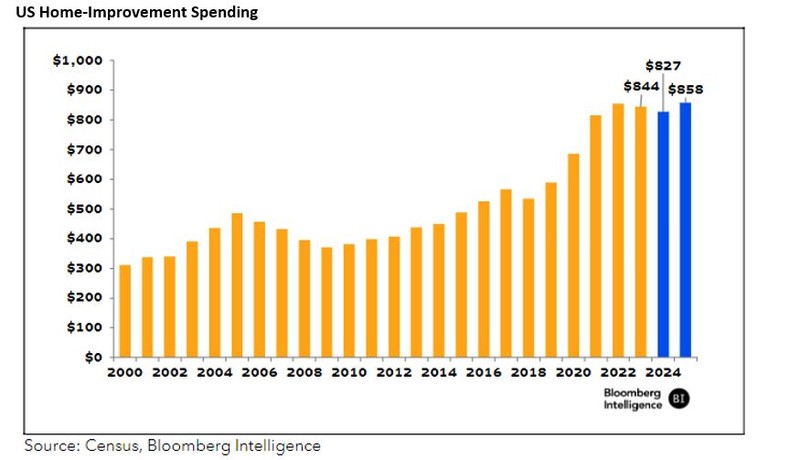Bloomberg Intelligence
This analysis is by Drew Reading, Lead Analyst, Homebuilding & Home Improvement, US, and Mike Campellone, Contributing Analyst, Credit, US. It appeared first on the Bloomberg Terminal.
Investments from a position of strength will enable Home Depot and Lowe’s to capitalize on a rebound in-home improvement spending that we think will emerge in 2025, with sales rising mid-single digits. While both retailers stand to benefit, Home Depot’s outsized exposure to pros could fuel stronger growth amid expectations for the segment to outpace DIY customers. Lowe’s has done well to narrow the operational gap with its rival, which is reflected in its relative stock performance and slimmer valuation discount.
Key takeaways
• Industry Rebuilds From 2024 Bottom: The $1 trillion North America home-improvement industry may return to growth in 2025, climbing mid-single digits after two years of declines. Our intermediate-term view is underpinned by a rebound in existing home sales from trough levels, $32 trillion in homeowners’ equity and the oldest US housing stock on record.

- Professionals Propel Industry Growth: The $500 billion market for pro contractors is projected to fuel industry growth over the next five years, climbing 4.4% annually vs. 3% for the DIY segment, according to HIRI. This should support higher sales growth at Home Depot given its 50% exposure– vs. 25% for Lowe’s — and $18 billion deal for SRS Distribution, which will accelerate its push among larger pro customers.
- Brick and Mortar Evolution Continues: Home Depot is embarking on its first meaningful store expansion in over a decade — adding 80 new stores through 2027 – to tap underserved markets while relieving pressure in congested locations, supporting sales and productivity. Conversely, Lowe’s has reduced its footprint through the sale of its Canadian operations and is testing new concepts with rural assortments and outlets to drive sales.
- Double-Digit Penetration Hammers Peers: Online penetration of 15% of total sales for Home Depot and 12% for Lowe’s stand far above the industry’s 8%, as the big-box peers leverage merchandising and supply-chain investments to grow channel share faster than smaller names. Lowe’s online penetration may reach the midteens and Home Depot the high teens in the next few years, contributing to above-industry sales growth.
- EPS Accelerates, Depot Leads Long Term: Home Depot and Lowe’s EPS should rebound in 2025, with our analysis suggesting mid-to-high-single-digit growth for both after a challenging 2024. Longer term, Home Depot’s aggressive push into the complex pro market and resumption of buybacks after a period of deleveraging could fuel more robust gains.
Already a customer? Access the full report here.
Not a terminal user? Click here to learn more.